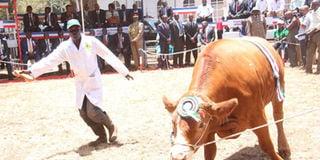Here’s what judges look out for when picking the champion bull

Winning champion bull weighing 600kg which was auctioned for Sh1million during the past Nairobi Trade Fair. The animal should have a good fat stock and its body structure should be even. PHOTO | KANYIRI WAHITO | NATION MEDIA GROUP
What you need to know:
- There are normally four categories for competition.
- Judges look at various factors before crowning an animal the champion or super champion bull.
- Livestock keepers said that the prolonged drought which hit various parts of the country over the past months had severely affected production.
- The PS for Livestock Andrew Tuimur said that drought that affected different parts of the country severely shocked the livestock industry resulting into lack of feeds and diseases such as foot and mouth disease.
Tens of admirers stuck their necks across a cattle enclosure at the Jamhuri showground in Nairobi last week as they watched a group of judges inspecting the well-built animals that had earlier been paraded before them.
Every year during the trade fair, and others, top farmers parade their steers before the judges who inspect and crown the animals.
Seeds of Gold sought to find out what the judges really look out for while searching for the best steer.
There are normally four categories for competition. These are class one (for bull below two years), class two (for bulls between two and three years), class three (for bulls between three and four years) and class four (for bull above for years).
The judges also pick the overall winner form the four classes, for the super champion title.
Once the animals have been awarded in their respective classes, they are taken to the auction market – inside the show – where they are sold to the highest bidder.
Adan Haji Yusuf, the chief judge for the event, said they look at various factors before crowning an animal the champion or super champion bull.
“First, the bulls that are allowed into the champion bull competition must be weighing 400kg and above. But there are also other several veterinary regulations, for instance the animal’s ancestral (historical) and health records,” explained Yusuf, who also doubles up as the MP for Mandera West Constituency, and has served as a judge in the steers’ competition for 37 years.
Yusuf added that they also look at factors such as the economy of keeping the animal, which include the weight of the steer in comparison to its age.
LIMITED GRAZING AREAS
“The animal should have a good fat stock and its body structure should be even. We further look at its back and the front part and the bone and muscles ratio,” explained the chief judge, adding that the higher the bone and muscle ration, the higher the economy.
There were 101 entries for the champion bull competition in total, a figure which was considerably lower compared to last year’s entries.
Livestock keepers said that the prolonged drought which hit various parts of the country over the past months had severely affected production.
Again, more individual farmers are slowly ditching beef farming for dairy due to limited grazing areas, a move which is dipping beef production, Yusuf pointed out.
Only three firms made entries into the bulls’ competition, which were Kenya Seed Company, BM and Agricultural Development Cooperation. There were no entries from private farmers.
“Steers are not zero-grazed as compared to their dairy counterparts as a result they require large open lands for grazing but subdivision of land or ranches among pastoralist limits beef farming,” Yusuf said, adding competition has been left to agricultural firms who still own large farms.
The PS for Livestock Andrew Tuimur said that drought that affected different parts of the country severely shocked the livestock industry resulting into lack of feeds and diseases such as foot and mouth disease.
Tuimur noted that while the country’s agricultural sector has went through turbulent times, the trade fair was impressive with innovators coming up with various technologies to respond to the needs of local farmers.





